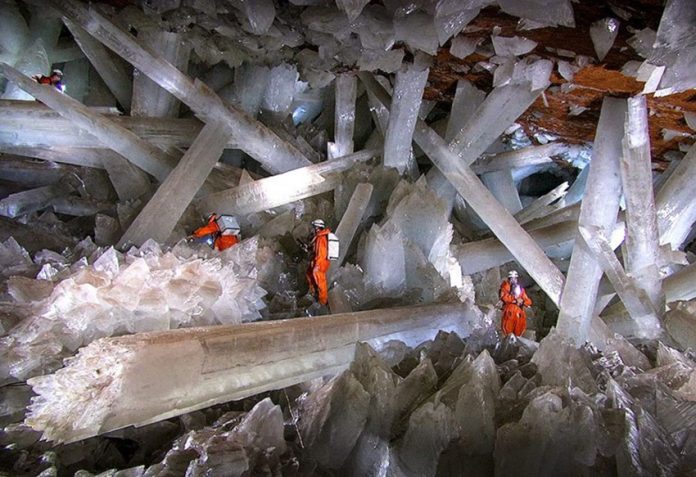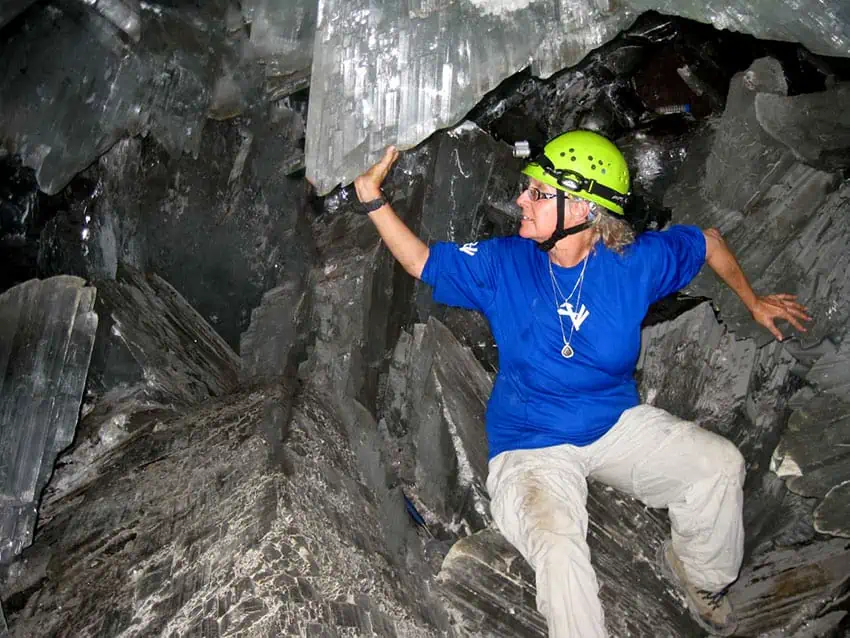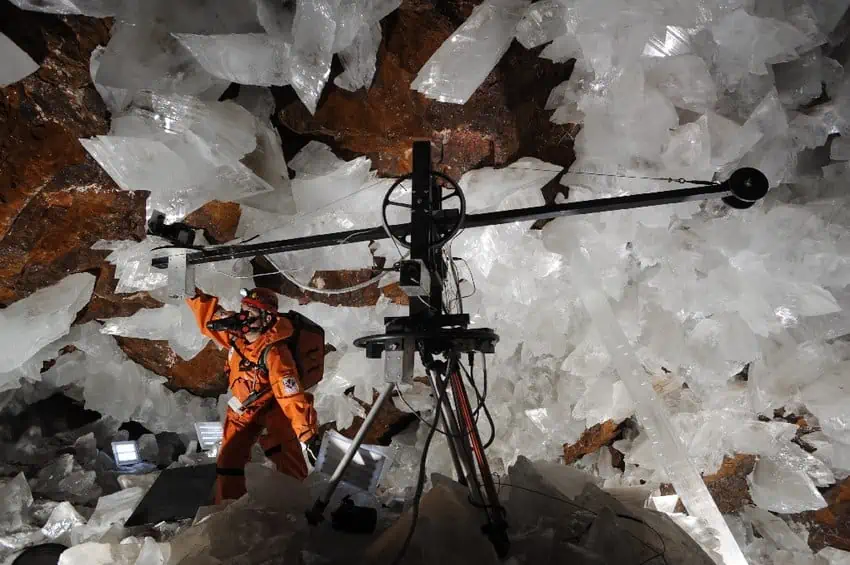20 jaar na de ontdekking de mysterieuze Naica Kristallengrot verbaast ons nog steeds
(mexiconewsdaily.com) April 2, 2021

De enorme kristallen waren tot 14 meter lang en twee meter dik, en bevonden zich in een grot die zo vijandig was dat niemand het langer dan een paar minuten kon uitstaan om erin te zijn: de hele wereld stond versteld toen de eerste foto’s van de Naica Crystal Cave ging viraal.
Terwijl we de 20e verjaardag van de ontdekking van de grot vieren, laat het ons nog steeds naar adem snakken van verbazing.
Deze ongelooflijke grot is een van de weinige plaatsen die – in één adem – “de mooiste plek op aarde” en “één stap verwijderd van de hel” kunnen worden genoemd. Het was alleen ooit toegankelijk via een tunnel in de Naica-mijn, de grootste lood-, zink- en zilvermijn in Mexico, geëxploiteerd in Chihuahua door Industrias Peñoles, maar vandaag staan zowel die tunnel als de grot volledig onder water. Maar dat kan juist in het voordeel van het natuurlijke fenomeen zijn.
Onlangs sprak ik met speleoloog en historicus Carlos Lazcano, de eerste wetenschapper ooit die voet zette in de Naica Crystal Cave. Hier is zijn herinnering aan die ervaring:
“Twintig jaar geleden werkten verschillende van mijn medestudenten geologie toevallig in de mijnen in Chihuahua, en op een dag ging ik daarheen om wat met ze om te gaan. Zo kwam ik de voorman van de Naica mijn tegen.

“Terwijl we aan het praten waren, vertelde hij dat ze een nieuwe zijtunnel hadden gegraven met het idee om daar een airconditioning te installeren voor de diepste niveaus van het systeem. Daarbij, zei hij, hadden ze ingebroken in een nieuwe grot: zou ik die willen bekijken?
“Ik zei hem dat ik dat zeker zou doen, en wel zo snel mogelijk omdat ik wist dat de vorige grotten die ze in Naica hadden gevonden grote kristallen bevatten. De meest bekende was La Cueva de las Espadas, de Grot van Zwaarden, die in 1910 was ontdekt. Hoewel de grot al 100 jaar systematisch werd vernield, bevatte hij nog steeds kristallen van wel vier meter lang, en het was zo fascinerend dat Ik was echt benieuwd hoe het eruit moet hebben gezien toen ze er voor het eerst binnenkwamen.
Lazcano vond zijn antwoord toen hij La Cueva de los Cristales binnenstapte.
“Het was een verrassing met hoofdletters! Ik was niet alleen verbaasd over de grootte van de kristallen, maar ook over de agressiviteit van de omgeving eromheen. De temperatuur was 50 graden Celsius (122 F) met 100% luchtvochtigheid.”
Toevallig kreeg Lazcano bezoek van Claude Chabert, een van de beroemdste speleologen van Frankrijk.
“In april of mei 2000 kregen we volledige toestemming om de grot te verkennen, dus wij tweeën waren de eerste speleologen die probeerden hem te bestuderen. We waren allebei opgewonden door die bizarre gigantische kristallen, maar tegelijkertijd konden we gewoon niet geloven hoe vijandig de grot was. We konden er niet langer dan vijf minuten achter elkaar in blijven! Als we probeerden de zes minuten te halen, hadden we het gevoel dat we doodgingen!”

Toen kwam het bij hem op om contact op te nemen met zijn vrienden van de Italiaanse La Venta Association, die wetenschappelijke ondergrondse expedities organiseert. Hij wist dat ze daar vulkanische grotten hadden verkend waar de temperatuur rond de 80 graden Celsius was, dus schreef hij ze en stuurde ze foto’s.
“Ik kon niet geloven hoe snel ze hier kwamen opdagen … en zo begon Project Naica!”
Het Naica-project, dat bestond uit 12 werkreizen om de grot te verkennen en alles erin te bestuderen, werd georganiseerd door La Venta Exploring Team, dat zijn naam dankt aan een speleo-archeologisch project uit 1990 langs Rio La Venta in Chiapas. Hier ontdekte en bestudeerde het team tientallen grotten, waarvan de meeste al in het jaar voor Christus door de Zoque-indianen werden gebruikt. 300. Sindsdien heeft La Venta projecten uitgevoerd van Myanmar tot Patagonië.
(lees verder at https://mexiconewsdaily.com/mexicolife/mysterious-naica-crystal-cave-still-astonishes/ )
Deadly Crystal Cave | National Geographic (5:43)
https://www.youtube.com/watch?v=wgUFb_l4DLE
20 years after its discovery, mysterious Naica Crystal Cave still astonishes
April 2, 2021

Its enormous crystals were up to 14 meters long and two meters thick, located inside a cave so hostile that no one could stand to be inside it for more than a few minutes: the whole world was stunned when the first pictures of the Naica Crystal Cave went viral.
As we celebrate the 20th anniversary of the cave’s discovery, it still leaves us gasping in astonishment.
This incredible cave is one of very few places that could be called — in the same breath — “the most beautiful place on earth” and “one step away from Hell.” It was only ever accessible from a tunnel in the Naica Mine, the largest lead, zinc and silver mine in Mexico, operated in Chihuahua by Industrias Peñoles, but today both that tunnel and the cave are entirely under water. But that may actually be to the natural phenomenon’s benefit.
Recently, I caught up with speleologist and historian Carlos Lazcano, the first scientist ever to set foot in the Naica Crystal Cave. Here is his recollection of that experience:
“Twenty years ago, several of my fellow students of geology happened to be working in mines in Chihuahua, and one day I went over there to hang out with them a bit. This is how I bumped into the foreman of the Naica mine.

“As we were chatting, he mentioned that they had dug a new side tunnel with the idea of installing an air-conditioning unit there for the deepest levels of the system. In the process, he said, they had broken into a new cave: would I like to take a look at it?
“I told him I certainly would, and as soon as possible because I knew that the previous caves they had found in Naica contained large crystals. The most famous was La Cueva de las Espadas, the Cave of Swords, which had been discovered in 1910. Although the cave had been systematically trashed for 100 years, it still boasted crystals up to four meters in length, and it was so fascinating that I was really curious how it must have looked the first time they entered it.
Lazcano found his answer when he stepped into La Cueva de los Cristales.
“It was a surprise with capital letters! I was amazed not only at the size of the crystals but also at the aggressiveness of the environment surrounding them. The temperature was 50 degrees Centigrade (122 F) with 100% humidity.”
By chance, Lazcano got a visit from Claude Chabert, one of France’s most famous cavers.
“In April or May of 2000, we got full authorization to explore the cave, so the two of us were the first speleologists to try to study it. Both of us were excited by those bizarre giant crystals, but at the same time, we just couldn’t believe how hostile the cave was. We couldn’t stay in it for more than five minutes at a go! If we tried to make it to six minutes, we felt like we were dying!”

That’s when it occurred to him to contact his friends at Italy’s La Venta Association, which organizes scientific underground expeditions. He knew that they had explored volcanic caves there where the temperature was around 80 degrees Celsius (176 F), so he wrote to them and sent them pictures.
“I couldn’t believe how fast they showed up here … and that’s how Project Naica got started!”
The Naica Project, which consisted of 12 working trips to explore the cave and study everything in it, was organized by La Venta Exploring Team, which got its name from a 1990 speleo-archaeological project along Rio La Venta in Chiapas. Here, the team discovered and studied dozens of caves, most of them used by the Zoque Indians as long ago as B.C. 300. Since then, La Venta has carried out projects from Myanmar to Patagonia. (read more at https://mexiconewsdaily.com/mexicolife/mysterious-naica-crystal-cave-still-astonishes/ )


Je moet ingelogd zijn om een reactie te plaatsen.